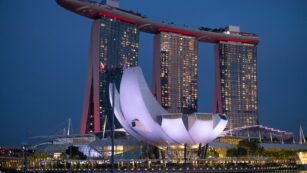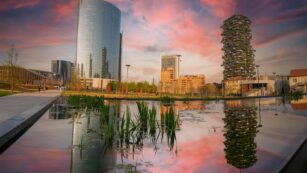In the world of architecture, innovation isn’t just a buzzword; it’s the cornerstone of modern building design. As cities grow denser and the global population rises, the push for sustainable, efficient, and aesthetically pleasing structures has never been more urgent. Innovative building design marries form and function, creating spaces that are as environmentally responsible as they are visually striking.
Innovative Building Design
Innovative building design merges aesthetics, sustainability, and advanced technology to meet the demands of growing urban populations. It involves structures that not only please the eye but also contribute positively to environmental sustainability and quality of life.
Key Elements of Innovation in Architecture
 Innovative architecture revolves around several critical elements that define and drive the advancement of building designs. They include:
Innovative architecture revolves around several critical elements that define and drive the advancement of building designs. They include:
-
Utilization of Advanced Materials: Architects often employ materials such as transparent aluminum and self-healing concrete to enhance durability and aesthetic appeal. These materials help extend the life of a building and reduce maintenance costs.
-
Integration of Technology: Smart systems are integral to innovative buildings, controlling everything from lighting and heating to security and energy consumption. This technology enables buildings to adapt to the needs of their occupants dynamically.
-
Eco-friendly Features: Features such as solar panels, green roofs, and rainwater harvesting systems are commonly integrated into modern designs. These features reduce a building’s carbon footprint while lowering operational costs.
-
Adaptive Design: Structures are increasingly designed to be multifunctional and adaptable to change. Walls and floors that can be reconfigured according to need, for example, accommodate evolving space requirements without additional construction.
The Impact of Sustainability on Modern Structures
 Sustainability significantly influences modern building designs, impacting both the construction process and the lifespan of structures. Here’s how:
Sustainability significantly influences modern building designs, impacting both the construction process and the lifespan of structures. Here’s how:
-
Reduced Environmental Impact: Buildings designed with sustainability in mind use less energy, water, and raw materials. This not only conserves resources but also minimizes the ecological footprint of urban development.
-
Increased Property Value: Sustainable buildings often demand higher market values due to lower operating costs and better environmental performance. Investors and occupants alike realize long-term savings.
-
Enhanced Occupant Wellbeing: Natural light, improved air quality, and use of non-toxic materials contribute to a healthier living and working environment, enhancing comfort and productivity.
-
Regulatory Compliance and Incentives: Modern sustainable designs comply with stringent environmental regulations, qualifying for governmental incentives, which can offset initial investment costs.
By harnessing these innovative and sustainable practices, architects and designers are crafting the future of urban living, fundamentally transforming how communities interact with their built environments.
The Technology Behind Innovative Building Designs
Advanced Materials Used in Construction
 Innovations in construction materials have played a pivotal role in transforming building designs. Materials such as transparent aluminum and self-healing concrete exemplify advancements that imbue structures with both enhanced durability and futuristic aesthetics. Transparent aluminum, for example, offers a lightweight, yet incredibly strong alternative to traditional glass, enabling more expansive and resilient architectural designs. Similarly, self-healing concrete incorporates microencapsulated healing agents that activate upon the appearance of cracks. This material significantly extends the lifespan of structures while reducing maintenance costs.
Innovations in construction materials have played a pivotal role in transforming building designs. Materials such as transparent aluminum and self-healing concrete exemplify advancements that imbue structures with both enhanced durability and futuristic aesthetics. Transparent aluminum, for example, offers a lightweight, yet incredibly strong alternative to traditional glass, enabling more expansive and resilient architectural designs. Similarly, self-healing concrete incorporates microencapsulated healing agents that activate upon the appearance of cracks. This material significantly extends the lifespan of structures while reducing maintenance costs.
Graphene and aerogels also contribute to modern construction by providing superlative thermal insulation and structural strength without adding significant weight. These materials allow architects to design buildings that are more energy-efficient, further supporting sustainability efforts.
Smart Technology Integration in Buildings
 The integration of smart technology in buildings revolutionizes the way they are managed and operated. Systems equipped with sensors and Internet of Things (IoT) technology enable real-time monitoring and control of various building operations. This includes energy usage, lighting, heating, ventilation, and air conditioning systems (HVAC), and even security measures.
The integration of smart technology in buildings revolutionizes the way they are managed and operated. Systems equipped with sensors and Internet of Things (IoT) technology enable real-time monitoring and control of various building operations. This includes energy usage, lighting, heating, ventilation, and air conditioning systems (HVAC), and even security measures.
For instance, smart thermostats adjust temperatures based on the occupancy and habitual patterns within spaces, optimizing comfort while minimizing energy consumption. Advanced security systems, equipped with biometric scanners and AI-driven surveillance, enhance safety and efficiency.
Moreover, dynamic glass technology, which can adjust its opacity to control solar gain and glare, exemplifies how smart technology adapates to both environmental conditions and occupant needs. This not only improves comfort but also reduces the reliance on artificial lighting and heating or cooling systems, driving down energy usage.

